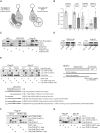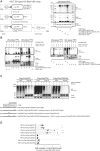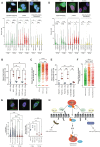TRIP12's role in the governance of DNA polymerase β involvement in DNA damage response and repair
- PMID: 40613707
- PMCID: PMC12231584
- DOI: 10.1093/nar/gkaf574
TRIP12's role in the governance of DNA polymerase β involvement in DNA damage response and repair
Abstract
The multitude of DNA lesion types, and the nuclear dynamic context in which they occur, presents a challenge for genome integrity maintenance as this requires the engagement of different DNA repair pathways. Specific "repair controllers" that facilitate DNA repair pathway crosstalk between double-strand break (DSB) repair and base excision repair (BER) and that regulate BER protein engagement at lesion sites have yet to be identified. Here, we find that DNA polymerase β (Polβ), crucial for BER, is ubiquitylated in a BER complex-dependent manner by TRIP12, an E3 ligase that partners with UBR5 to restrain DSB repair signaling. Furthermore, we find that TRIP12, but not UBR5, controls cellular levels and chromatin loading of Polβ. Required for Polβ foci formation, TRIP12 influences Polβ involvement after radiation-induced DNA damage, a process regulated by TRIP12-mediated ubiquitylation of Polβ. Notably, excessive TRIP12-mediated engagement of Polβ affects DSB formation and radiation sensitivity, underscoring its role in promoting precedence for BER over DSB repair. The herein discovered function of TRIP12, in the governance of Polβ-directed BER, supports a role for TRIP12 in assuring BER lesion removal at complex DSB sites to optimize DSB repair at the nexus of DNA repair pathways.
© The Author(s) 2025. Published by Oxford University Press on behalf of Nucleic Acids Research.
Conflict of interest statement
None declared.
Figures








Update of
-
TRIP12 governs DNA Polymerase β involvement in DNA damage response and repair.bioRxiv [Preprint]. 2024 Apr 10:2024.04.08.588474. doi: 10.1101/2024.04.08.588474. bioRxiv. 2024. Update in: Nucleic Acids Res. 2025 Jun 20;53(12):gkaf574. doi: 10.1093/nar/gkaf574. PMID: 38645048 Free PMC article. Updated. Preprint.
References
MeSH terms
Substances
Grants and funding
- USA Mitchell Cancer Institute (MCI) Cellular and Biomolecular Imaging Facility
- R01 CA238061/CA/NCI NIH HHS/United States
- P30 CA047904/CA/NCI NIH HHS/United States
- P41 GM103504/GM/NIGMS NIH HHS/United States
- R01 ES014811/ES/NIEHS NIH HHS/United States
- USA MCI Core Facility
- ES014811/NH/NIH HHS/United States
- USA MCI Flow Cytometry Facility
- CA238061/NH/NIH HHS/United States
- Abraham A. Mitchell Distinguished Investigator
- NKI-2010-4877/the Dutch Cancer Society
- CA148629/NH/NIH HHS/United States
- R01 CA148629/CA/NCI NIH HHS/United States
- Dr. Robert Browning Foundation
- Legoretta Cancer Center Endowment Fund
- NIH
- Brown University
- U01 ES029518/ES/NIEHS NIH HHS/United States
- ES029518/NH/NIH HHS/United States
- P30CA047904/CRUK
- Netherlands Cancer Institute
LinkOut - more resources
Full Text Sources

